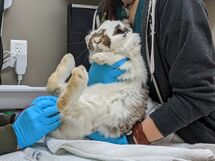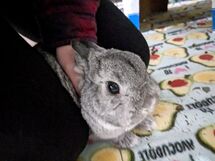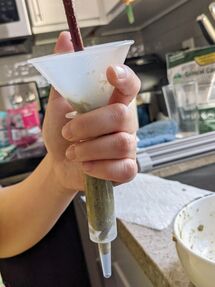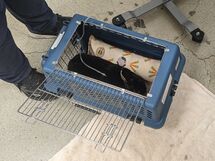Medicating your rabbit
This article is incomplete because it lacks depth or is unfinished. Help by expanding it.
This page goes over instructions, tips, and resources for a few basic medical procedures that rabbit owners are likely to need to do for their rabbits at least once in their lifetime.
Giving an enema
Enemas can help hydrate hardened fecal matter when facing a GI stasis crisis. Please contact your veterinarian first before trying to give an enema to your rabbit, as the risk of colon puncture is a real possibility.[1]
The following are some resources on giving rabbits an enema:
- Dana Krempels, How Administer an Enema to Your Rabbit
Giving eye drops
Below are some relevant vidoes about giving rabbits eye drops.
A few websites with their own instructions and videos:
- The Rabbit Doctors. How to: Apply eye drops
Giving ear drops
Below are some relevant vidoes about giving rabbits ear drops.
Nebulizing

Nebulizing is a treatment often given for upper and lower respiratory infections.
Human nebulizers can be reused for rabbits, but please check with your veterinarian for dispensing preferences. One such affordable nebulizer model includes the Omron CompAir NE-C801.
The following are some resources on nebulizing rabbits.
- Rachel Sibbald. (2019). Nebulizing Rabbits
- Ontario Rabbit Education Organization. Nebulizing
- Kirk Lowis, M.A. Nebulizing Rabbits
- Lucile C. Moore & Kathy Smith. (2008). When Your Rabbit Needs Special Care: Traditional and Alternative Healing Methods. Nebulizing
Here are some videos about placing rabbits in a nebulizer.
- Cooper the Pooper. (2024). MINI's nebulizer setup.
Below are some experiences with nebulizing as a treatment.
- Lorraine Howard. Case Study: Guinness' Nebulizer Treatment for Pneumonia
Oral medication
While some rabbits may enjoy the taste of their medication and eat it from the syringe directly with pleasure, most often, rabbits do not like having syringes near their face and liquids squirted forcefully in their mouths. Syringe-feeding oral medications can be stressful and a struggle.
If you need to feed a pill to your rabbit, obtain a pill crusher to help convert it to a more liquid form.
The following tips may help bribe your rabbit into voluntarily eating their medication instead of needing to forcefully restrain and medicate them.
- Tricking your rabbit with fruit or another treat either by putting the medication in the middle of the treat or syringing in medication in your rabbit's mouth from the side while the bunny is busy trying to eat the treat.
- Drizzle the medication on a lettuce leaf, fruit slice, or other treat. Freeze-dried vegetables are great at soaking up medication and less sugar-laden than fruit choices. Banana and apple slices work well at masking most tastes. While bread is not recommended as a regular food for rabbits due to the large amounts of starch, it is safe in limited amounts and small bites of whole wheat bread can be used to soak up the medication and fed as a treat.
- Dress their pellets with the medication. This can be done either in a spoon or a bowl depending on pellet quantity. Often, if the rabbits won't consume the pellets immediately, they will nibble on them over the next hour and consume their medication effectively that way. Here is an image album from /u/PeppermintBee demonstrating the technique.
- Mixing the medication with baby food, a sugar-free jam, or applesauce to mask the taste.
- Ask your veterinarian to compound the medication with a sweet flavor like apple, banana, or marshmallow.
If no amount of bribery will work, the following are some tips to help you restrain your rabbit:
- Use a two-door carrier to catch your rabbit and use the top entry to corner and stuff a syringe in their mouth.
- Catch your rabbit in a carrier and walk around for a minute or so to slightly stress the rabbit and make them easier to handle.
- Use an unfamiliar location to medicate your rabbits like a table top, bathroom, or dresser surface.
- While kneeling on the ground, hold your rabbit firmly between your thighs and block the rear entry with your feet so they are unable to back out of the trap. Bend over your rabbit to put the syringe in their mouth. If you have a bad back, you can make a similar restraining position on a low table with your chest, armpit, and arm.
- Use a bunny burrito for restraint. See Grooming#Bunny burrito for tips.
As a general tip, we recommend giving the best tasting medications first to your rabbits, especially if they'll eat them on their own. Rabbits will tend to thrash and resist harder and harder once they taste medication that they don't like, even if the latter medicines are better tasting.
The following links have more information on methods on giving your rabbit their oral medication.
- Suzanne Smith. (2001). Giving Medicine to Your Rabbit
- Flick. (2009). Syringing Meds 101
Here are some videos about various strategies to orally medicate rabbits.
- The University of Edinburgh. (2020). Client Support - Rabbit Oral Supplement
Syringe feeding
Force feeding recovery foods such as Critical Care can be a much more daunting task than oral medications due to the amount of food that needs to be fed and the amount of time needed for the procedure. This is something that most rabbit owners will need to learn to do due to bouts of GI stasis, dental issues, or during recovery from a major surgery such as a spay.
If you are unable to locate a syringe for oral feeding in an emergency, you can try to assist feed by using a Ziploc bag. Fill the bag with the liquid food, cut a small corner off, and squeeze the food out of the bag through the tip to feed.
A few tips specific to syringe feeding recovery food vs. medicating a small amount of medication:
- Give very small volumes of food (less than 1cc at a time) to prevent aspiration.
- Aim the tip at the opposite cheek rather than the back of the throat to prevent shooting food directly down the throat.
- Use a large syringe (15cc) and add more water as needed so the food flows out smoothly. You can also cut the tip of the syringe with a pair of scissors to make the feeding opening larger.
Please see the #Oral medication section above for more general tips on handling your rabbit for medication.
The following are a few articles with tips about syringe feeding rabbits:
- All Creatures Rescue & Sanctuary. (2008). Tips on hand feeding rabbits and guinea pigs
- Rabbit Welfare Association & Fund. Syringe feeding guide
- BunnyHugga. (2010). Nursing rabbits
The following are videos to help demonstrate different effective techniques of restraining a rabbit for force feeding:
Subcutaneous injections
Subcutaneous injections, also abbreviated as SC, SQ, sub-cu, sub-Q, or subcut injections are given in the fatty layer of tissue under the skin. This method is commonly used to inject medications as well as fluids for hydration.
Some tips with subcutaneous injections:
- Roll the vial back and forth if it needs to mixed or warmed up before use. Do not shake vigorously to mix as it can add air into the solution and make it difficult for accurate dosage.
- For penicillin G, larger gauge needles (19- to 21- gauge) are recommended because the solution is so thick and viscous.
- When drawing medication from the bottle, first pre-fill the syringe with air before inserting the needle. You can carefully pump the syringe back and forth a few times to decrease the amount of obvious air bubbles.
Below are some additional resources about giving subcutaneous injections to rabbits.
- MediRabbit, Naomi Heinsma, Basic instructions for subcutaneous injections in rabbits
The following are videos of demonstrations of the administration of subcutaneous injections in rabbits.
Subcutaneous fluids
Subcutaneous fluids, also abbreviated as SC, SQ, sub-cu, sub-Q, or subcut fluids are fluids given in the fatty layer of tissue under the skin. Many rabbit owners will never need to learn how to do this, but health issues like dehydration, megacolon, and kidney disease may require owners to learn how to do so at home.
There are two ways of giving fluids to rabbits: 1) using a syringe set, and 2) using a drip line (giving) set.
A few tips when giving fluids to rabbits:
- Common needle gauges when giving fluids to rabbits range from 18 gauge to 21 gauge or thinner. The lower the number, the larger the diameter of the needle and the faster the fluids can be given. However, a thinner needle may be more comfortable to your rabbit.
- If your fluid bag is cloudy or discolored, discard the bag as it may be contaminated.
- If you are giving a large amount of fluids to your rabbit (over 20ml), it is recommended to warm the fluids to around body temperature (~100°F) first for their comfort and to prevent lowering their body temperature if your rabbit is unwell. To warm them, you can place the bag directly in a warm bowl of water with the ports out of the water, or if you would like to warm the line as well in a giving set, water-tight in a Ziploc bag. Do not submerge the ports or line directly in water as it can introduce contamination. A sous vide cooker or tea kettle with exact temperature controls can be very helpful for this purpose. A full bag of fluids may take 10-15 minutes to warm up. Do not overheat the fluids - it can cause serious burns under the skin.
- You may see some (or a larger amount if unlucky) blood or blood-tinged fluid when removing the needle sometimes. This is not a serious issue and means that you hit a blood vessel in the skin when inserting the needle. Pinch the insertion hole or put pressure on it with a paper towel or gauze and make sure it clots and stops bleeding.
- If using a giving set, always put a new needle on the end of the line when you finish a fluid administration session to prevent contamination traveling up from an old needle.
- If you have issues inserting and positioning the needle under the skin more than twice, change to a new needle to minimize discomfort.
The following are videos of demonstrations of the administration of subcutaneous fluids using a giving set in rabbits.
The following are videos of demonstrations of the administration of subcutaneous fluids using a syringe set in rabbits.
Taking temperature
Normal rectal temperature for a healthy rabbit should be between 101-104°F or 38.3-40°C.
Infrared thermometers for the ear are not accurate in rabbits as they use their ears as their main thermoregulatory organ, and temperatures will fluctuate greatly whether they are hot or cold.
Here are some resources on taking your rabbit's temperature.
- House Rabbit Resource Network, Body Temperature
- BunSpace, Taking A Rabbit's Temperature
Further reading
- House Rabbit Society, FAQ: Medicating Your Rabbit
See also
References
- ↑ Kathy Smith, Rabbit Health in the 21st century, 2003, p43.






